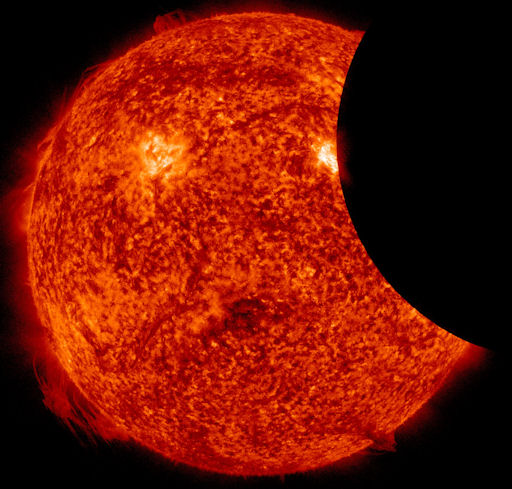SOLAR ECLIPSE: Today, the new Moon passed in front of the sun, off-center, producing a partial solar eclipse. The only place to see it was from space. NASA's Solar Dynamics Observatory (SDO) sends this picture from geosynchronous orbit approximately 36,000 km above Earth's surface:
Using a bank of 16 megapixel cameras, SDO observed the event at multiple extreme ultraviolet wavelengths. Scan the edge of the Moon in this 171 Å image: The little bumps and irregularities you see are lunar mountains backlit by solar plasma.
Beyond the novelty of observing an eclipse from space, these images have practical value to the SDO science team. The sharp edge of the lunar limb helps researchers measure the in-orbit characteristics of the telescope--e.g., how light diffracts around the telescope's optics and filter support grids. Once these are calibrated, it is possible to correct SDO data for instrumental effects and sharpen the images even more than before.
Stay tuned for an eclipse movie!
[video:http://www.youtube.com/watch?v=a51eNT6g97k]

Solar wind
speed: 431.0 km/sec
density: 0.7 protons/cm3
explanation | more data
Updated: Today at 1511 UT
X-ray Solar Flares
6-hr max: C1 1148 UT Feb21
24-hr: C1 1148 UT Feb21
explanation | more data
Updated: Today at: 1600 UT
![]()
Daily Sun: 21 Feb 12
There is a slight (10%) chance of M-class solar flares today from sunspot AR1422. Credit: SDO/HMI
![]()
Sunspot number: 72
What is the sunspot number?
Updated 20 Feb 2012
Spotless Days
Current Stretch: 0 days
2012 total: 0 days (0%)
2011 total: 2 days (<1%)
2010 total: 51 days (14%)
2009 total: 260 days (71%)
Since 2004: 821 days
Typical Solar Min: 486 days
Updated 20 Feb 2012
The Radio Sun
10.7 cm flux: 111 sfu
explanation | more data
Updated 20 Feb 2012
![]()
Current Auroral Oval:
Switch to: Europe, USA, New Zealand, Antarctica
Credit: NOAA/POES
![]()
Planetary K-index
Now: Kp= 1 quiet
24-hr max: Kp= 3 quiet
explanation | more data
Interplanetary Mag. Field
Btotal: 3.0 nT
Bz: 1.1 nT south
explanation | more data
Updated: Today at 1513 UT
![]()
Coronal Holes: 21 Feb 12
A solar wind stream flowing from the indicated coronal hole should reach Earth on or about Feb. 25th. Credit: SDO/AIA.




